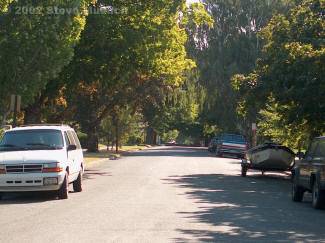Residential Streets

Figures 1: Residential Streets

Figures 2: Residential Streets
Assumed Traffic
Low speed, low traffic volume and relatively light loadings. Truck traffic is limited to those vehicles that provide residential services such as garbage trucks, delivery trucks and the occasional moving van.
| Vehicle Type | Vehicles per day |
Vehicles per year |
ESALs per year |
|---|---|---|---|
| Cars and Light Trucks | 500 | 200,000 | 140 |
| Medium Trucks and Buses | 10 | 4,000 | 80 |
| Heavy Trucks and Buses | negligible | negligible | negligible |
| Totals | 510 | 204,000 | 220 |
Design Considerations
If buses (school or public transit) use or are anticipated to use the residential street on a regular basis the street should be designed using an approved design procedure. The National Asphalt Pavement Association and State Asphalt Pavement Associations cooperated to fund and develop a simplified, no cost pavement design tool (PaveXpress) that incorporates AASHTO 1993 pavement design methodology for use by pavement design engineers.
Construction Considerations
If the residential street is fully paved before the surrounding homes are built, the pavement may be damaged by heavy construction traffic such as loaded dump trucks, material delivery vehicles and construction equipment. In most cases it is advantageous to pave a residential street in two stages. First, before home construction beings a layer of Asphalt Treated Base (ATB – in accordance with site paving thicknesses) creates a paved street that allows construction vehicles to access the site without tracking mud or damaging the subgrade. It also allows potential buyers the opportunity to see their homes in a cleaner environment.
Recommended References
- American Association of State Highway and Transportation Officials (AASHTO). (1993). AASHTO Guide for Design of Pavement Structures. American Association of State Highway and Transportation Officials. Washington, D.C. (www.aashto.org). Pavement designs using the AASHTO 1993 calculations can be performed by employing the pavement design software program at PaveXpress.
- The Asphalt Institute. (1999). Thickness Design – Asphalt, Manual Series No. 1. The Asphalt Institute. Lexington, KY. (www.asphaltinstitute.org)
- The Asphalt Institute. (no date given). How to Design Full-Depth Asphalt Pavements for Streets, Information Series No. 096. The Asphalt Institute. Lexington, KY. (www.asphaltinstitute.org)
- National Asphalt Pavement Association (NAPA). (2001). HMA Pavement Mix Type Selection Guide, Information Series 128. National Asphalt Pavement Association. Landham, MD. (www.asphaltpavement.org)
- National Asphalt Pavement Association (NAPA). (1995). Thin Hot Mix Asphalt Surfacings, Informational Series 110. National Asphalt Pavement Association. Lanham, MD. (www.asphaltpavement.org)
Design Catalog



